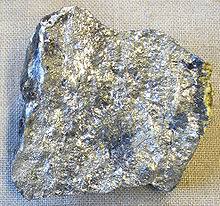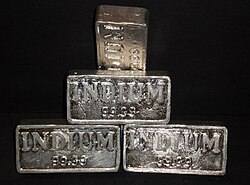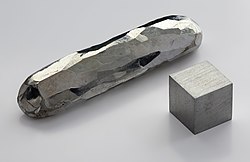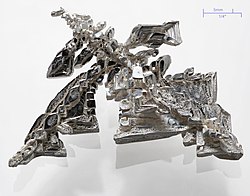Tellurium
 This blog, being written for the International Year of Chemistry, taking one element each week has finally arrived at week 52 and element 52 Tellurium.
This blog, being written for the International Year of Chemistry, taking one element each week has finally arrived at week 52 and element 52 Tellurium.
Although I spent 4 years studying Chemistry and many more working in the field, when I started this blog last year I realised that I had never heard of the 52nd element - Tellurium . How could that have happened I wondered.
During the year I realised that there were other elements with which I was not familiar. I learned a little more about some of them during the year.
I also came across other chemists who had had the same experience, one had even traveled the world to try to find out about the many rare and not generally studied elements.
So what of Tellurium? It appears in the same group as oxygen, sulphur and selenium and is a non metal, but Tellurium has some metal characteristics and is classified as a semi metal.
Tellurium is occasionally found as a free element but is usually found combined with Gold.
Tellurium and all its compounds are highly toxic.
In spite of its rarity and toxicity, it does have some uses in semiconductors and as alloys with other metals.
Antimony
The 51st element is called Antimony. Its name comes from the Greek words anti and monos which mean "not alone" and its symbol Sb from its Latin name Stibium.
Metallic Antimony is an extremely brittle metal of a flaky, crystalline texture. It is bluish white and has a metallic lustre.
Antimony is sometimes found as a free element but more often as its sulphur compound Antimony Sulphide.
Antimony and many of its compounds are toxic so this limits its uses though it has in the past been used as coins. It isn't very suitable for use in coins as it wears away relatively easily.
Antimony is used in the electronics industry, in alloys with other metals and in batteries.
Tin
The 50th element is one that is very familiar to most people - Tin. Long before children learn the word science they learn about Tin - the container for storing biscuits and foods such as baked beans, fruit and pet food.
The scientific symbol for Tin is Sn. This name comes from Stannum the latin word for Tin .
Known for thousands of years, Tin was mixed with copper to make bronze.Tin is a silvery white metal.
The cans which we call tin cans are not made of pure Tin but are actually steel cans with a thin layer of Tin covering them.Tin is also used in solders.
Window glass is made by floating molten glass on molten Tin . This is known as the Pilkington Process.
Experiment of the week
To make a flat sheet of fat using molten ice.
You will need:
About 15 ice cubes
A plastic or metal tray
A saucepan or heat proof container
250g lard
Adult supervision
What to do:
Place the ice cubes in the tray and allow to melt. The melted ice should be a minimum of 1cm deep. Add more ice if necessary.
In the saucepan melt the lard.
Gently pour a thin layer of the molten lard onto the molten ice (water).
Allow to cool. Remove the sheet from the tray.
Make more sheets of lard as required.
Indium
The 49th element is indium, another metal with a silvery white appearance. Like Cadmium, indium is a soft metal. It has a low melting point - 156°C and can be mixed with gallium to make an alloy which is liquid at room temperature
It is used for making some electronic components, as a replacement for silver in mirrors and as a solder.
The name indium comes from the word indigo. Indigo is a dark blue colourful often cited as being one of the rainbow colours.
Experiment of the week
Investigate the colour indigo
You will need:
a light source, the sun or a light bulb
A CD
Adult supervision
What to do:
shine the light on the back of the CD
You should see all the colours of the rainbow as the light is split into its constituent colours.
Cadmium
The 48th element is Cadmium and is symbolised using the letters Cd.
Cadmium is a silver metal, but although it is next to silver on the periodic table it's colourful is the only similar trait the two elements have.
Cadmium is a soft metal which can be easily cut with a knife. Another important thing to mow is that it is toxic and therefore it is unlikely that you will come across it in a school setting.
It's most common use is in Ni-Cd batteries - rechargeable batteries.
Experiment of the week
To compare Ni-Cd and NiMH (Nickel Metal hydride) batteries.
You will need
An AA Ni-Cd battery
a AA NiMH battery
2 2.5V light bulbs
2 bulb holders
2 AA battery holders with flying leads
4 crocodile clips
Timer
Adult supervision
What to do
Ensure the batteries are fully. Barged.
Make up 2 circuits with the bulbs in the bulb holders connected to the battery holders.
Insert the Ni-Cd battery into one circuit and the NiMH battery into the other circuit.both the lights should light.
Start the timer.
Measure how long both bulbs light for to measure which battery is the best.
Silver
Number 47 on the periodic table is silver, a well known metal which most of you will be familiar with. It has a characteristic "silver" colour. This metal is quite rare and therefore valuable. It is used in jewellery as it is malleable. The fact that it is very stable in air also increases it's suitability for use in jewellery and other decorative and useful items. Because it doesn't react with air it keeps it's nice shiny silvery appearance.
The chemical symbol for silver is Ag. This symbol comes from the Latin name for silver Argentum.
Silver is found as an ore so it can be mined in the same way as we mined the chocolate chips from cookies when we were investigating copper earlier in the year.
Silver has no known biological role and isn't found in the human body.
Silver doesn't support the growth of bacteria and is therefore often used for chalices where many people are going to drink from the same cup.
As well as being used in jewellery and silverware, silver is also used in photography, mirror production, for coins and dentistry. A compound of silver , silver iodide is used to get rain clouds to rain.
Silver forms compounds with the halides, hydrogen, fluorine, chlorine, bromine and iodine. It also forms compounds with covalent elements such as oxygen, sulphur,
Selenium and tellurium.
Experiment of the week
To see if bread soda solution or washing soda make a better silver cleaner.
You will need:
2 Aluminium foil trays
Washing soda
Bread soda
Hot water
2 pieces of silver equally tarnished
A spoon
A timer
Adult supervision
What to do:
Put apiece of dirty or tarnished silver into each aluminium foil tray. Foil containers used by take away restaurants for rice are ideal.
Put a spoon of washing soda into one tray and a spoon of bread soda into the other one.
Pour equal amounts of hot water into each container.
Start the timer.
After 2 minutes remove both pieces of silver and compare. Which cleaning solution resulted in the cleanest silver?
Report your findings below.
Additional experiment - Compare your home made cleaning solution to a commercially available one.



